Polymnia (ship)
|
||||||||||||||||
|
||||||||||||||||
|
||||||||||||||||
The Polymnia was the first four-masted full ship built in Germany . The ship was named after one of the nine muses , the "Polymnia", also " Polyhymnia ".
history
The ship was launched on January 16, 1886 at Blohm & Voss in Hamburg and was delivered to the B. Wencke Söhne shipping company on March 10, 1886 . Industrialization had led to fundamental changes in shipbuilding, as the use of iron and appropriately riveted masts kept sailing shipping competitive with steam shipping for the time being. In 1906 she was sold to the Rhederei AG von 1896, Hamburg and was last under the command of Captain OA Schellhass.
The ship
The Polymnia was 88.57 m (290'7 ") long, 13.10 m (42'7") wide and had a draft of 7.24 m (23'9 "). The tall ship was measured at 2129 GRT. The ship made fast journeys under the captains V. Diedrichsen, G. Schmidt, M. Ipland , A. Molzen and Albert Schellhaß to North and South America and Australia. In order to save money, the mizzen mast , always the last mast of a full ship, was replaced by a mizzen mast with a mizzen sail in 1896 , making the ship a four-masted barque .
On March 10, 1907, the Polymnia stranded on Bayly Island near Cape Horn and could no longer be recovered. The crew was rescued by the Argentine fishing cutter Garibaldi and initially brought to Ushuaia . The crew later reached Punta Arenas on board the steamer Oreste .
- Difference in rigging between a full-masted ship and a four-masted barque
Footnotes
- ↑ Jochen Brenncke: "Windjammer", the great report on the development, travels and fate of the queens of the seven seas. In addition, a critical examination of the transition from the material wood to the construction of tall ships made of iron. Koehler, 1968, p. 22 .
- ↑ Information about the ship accessed on February 14, 2019
- ↑ Pictures from Friedrich W. Baier accessed on February 14, 2019
- ^ German Society for Shipping and Marine History e. V. (Ed.): Ship and Time . No. 20 . Köhlers Verlagsgesellschaft, Hamburg 1984, p. 68 .
- ↑ Fernando Hartwig, Magdalena Eichholz: Naufragios en el Océano Pacífico Sur . tape 1 . Penguin Random House Grupo Editorial Chile, Santiago de Chile.

